Summary Background
A SUMMARY OF THE ECONOMIC CONDITIONS IN NORTHWEST MICHIGAN
The CEDS summary background information for the northwest Michigan region answers the question “What have we done?” It describes the current economic conditions (see Appendix C) and helps present a clear understanding of the relevant economic issues. The data presented in the summary background and appendices is important to connect with the Strengths, Weaknesses, Opportunities and Threats (SWOT) analysis discussed later in the CEDS.

Total Population
309,563
Networks Northwest

Unemployment Rate
4.2%
Networks Northwest

High School Graduate or Higher
92.85%
Networks Northwest

Civilian Labor Force
147,805
Networks Northwest
HOUSING
Housing is one of our most basic human needs: where we live affects our health, wealth, access to opportunity and quality of life. Without safe, adequate, affordable housing, individuals face serious challenges to meeting their basic needs. When area residents struggle to meet their basic housing needs impacts are felt throughout the community. On our roads, residents commute further between work and home, in our schools, we struggle with declining enrollment as young families leave our communities to find more affordable housing; and in our businesses, which lose customers when residents have less disposable income due to high housing and transportation costs.
Shortages of affordable housing exist throughout the Northwest region of Michigan, and because of this, many families live farther from jobs, schools,
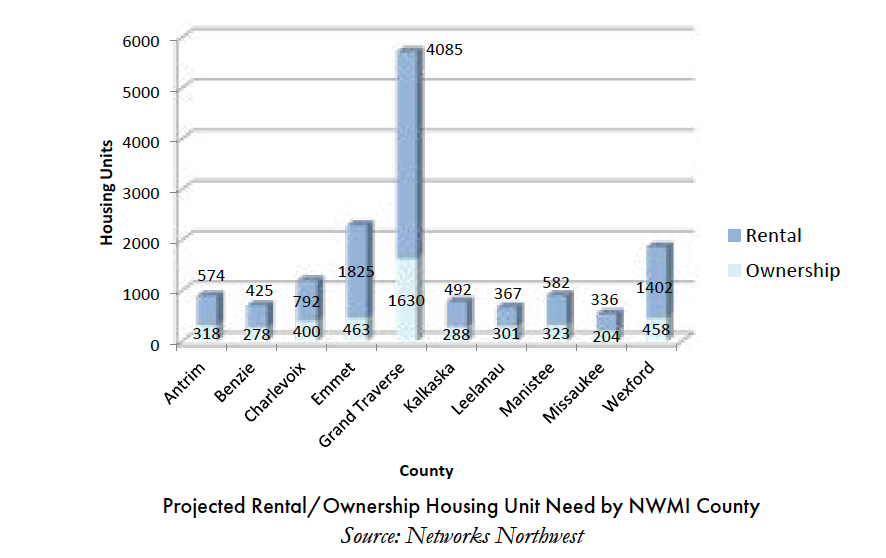
and shopping to find homes they can afford. Housing shortages also occur when developers focus on building large single-family homes which have been profitable for developers in the past but do not meet the needs of the community. Focusing on building single-family homes limits the potential for building other types of housing in the region such as rental units, mixed use developments, smaller houses for senior citizens, and housing for those with disabilities.
Finally, costs are being driven up by suppliers unable to keep pace with the demand and by an unprecedented increase in construction costs of land, labor and materials, particularly in high-growth areas of Michigan.
The good news is that the region is served by numerous public agencies, nonprofits, and private sector interests that endeavor to address the full impact of these affordable housing challenges.
WORKFORCE TALENT
Capacity, Attraction & Retention
The following sets of data show information about our local workforce. This data shows us that:
- Unemployment rates spiked in April 2020 but have been steadily declining ever since.
- Approximately 24% of the region’s workforce have “Some College, No Degree” as their highest level of education; more work should be done to determine actual credentials held by the workforce, regardless of whether a college degree is attained.
- The working-age population has declined in the past five years. Since the number of those under the age of 19 has also declined, we expect that this trend will continue in the future. At the same time, retirement and near-retirement age groups have increased so significantly that the overall population has increased.
- Approximately 60% of the population has less than an Associates Degree. While that may fit with the overall distribution of projected job demand by educational attainment, it is not sufficient for high-wage, high-demand jobs. In addition, the category “Some College, No Degree” does not accurately reflect the shorter-term credentials that may be held by local talent.
- Since 2013, the population ages 35 to 54 has decreased significantly. At the same time, all population groups over the age of 55 have increased. The population under 19 years has decreased as well, indicating continued future decreases of working-age populations.
The year 2020 has shown the first significant spike in unemployment since the great recession, due to the impact of the COVID-19 pandemic. The unemployment rate for all of 2019 was 4.1% for the region, with January 2020 through March 2020 showing similar numbers. The spike in April 2020, the height of business shut-downs, registered 27.4%. Fortunately, this number has been steadily declining ever since.
CHILD CARE
There are approximately 11,400 children aged 0-5 with all parents in the labor force in Northwest Michigan (NWMI). Even before COVID-19, there was already a gap in childcare capacity of about 900 children. The closure of child care providers creates immediate impacts and damages the workforce. A recent analysis by the Center for Progress indicates that as much as 41% of capacity statewide could be lost long-term without strong federal support. This could leave thousands of parents in the region without child care options, which for many will be a barrier to employment.
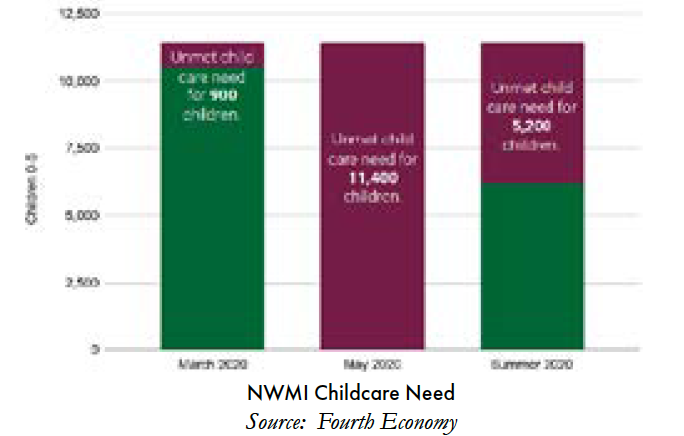
PANDEMIC
In the spring of 2020, the State of Michigan issued orders to temporarily restrict in-person work, travel, and gatherings in public places in order to mitigate the spread of the COVID-19 virus and to protect public safety. Michigan was one of many states to do so. As a result, significant economic disruption occurred throughout Northwest Lower Michigan that affected businesses, families, and local units of government. A Covid-19 Impact Analysis prepared by Fourth Economy identified the following economic impacts associated with government’s response to COVID-19:
- It is estimated that 23% of workers were able to work from home during the pandemic.
- Nearly 24% of workers in the region were not able to work from home which led to furloughs and terminations.
- The tourism sector is a major employer in Northwest Michigan and was hit hard by the pandemic leading to lasting impacts due to the global pandemic. The region has seen a decline in travel and hotel occupancies, leading to the cancellation of the 2020 National Cherry Festival in Traverse City, Michigan.
CLIMATE CHANGE
Climate Scientists have presented objective data concerning expected changes to our region. The following data and figures were gathered from the National Conference of State Legislatures, with a document titled “Michigan- Assessing the Costs of Climate Change”. During the past century, Michigan’s average temperature has risen by 3.9 Degrees. Models indicate that Michigan could become hotter and drier throughout this century. By 2030, Michigan summers will resemble those of present-day Ohio. Precipitation is also projected to increase by 20 percent to 40 percent in the Midwest. However, the increase in summer and winter temperatures will outweigh the predicted increase in precipitation causing an overall drier climate in Michigan that:
- Threatens the integrity of the Great Lakes-St. Lawrence shipping route.
- Will cause northward migration of plant and animal species, effecting state hunting, fishing, wildlife, and nature tourism industries.
- Is likely to affect agriculture and forestry.
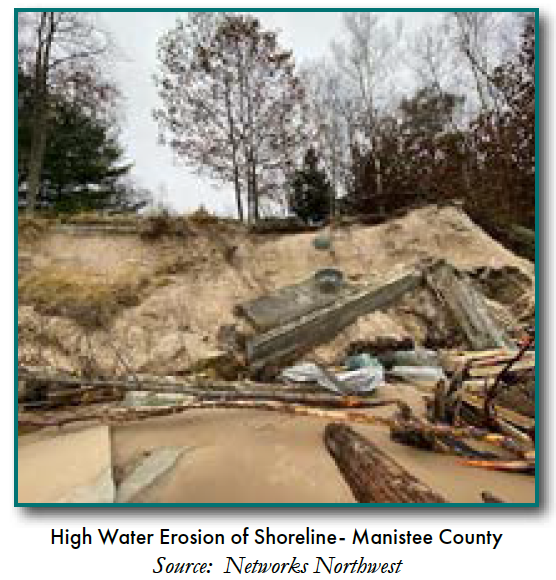
One major indicator of rising Michigan temperatures is the reduction of ice cover on the great lakes during winter months. Grand Traverse Bay’s winter ice coverage has steadily decreased. Prior to 1950 Grand Traverse Bay would ice over eight of ten winters.
Since the early 2000’s the bay has iced over three of ten winters. The Great Lakes are also likely to experience changes in surface temperature, evaporation rates, surface currents and ice cover affecting water levels. Some models predict that water levels in the Great Lakes will decline 1.5 feet to 8 feet by 2100, disrupting commercial shipping infrastructure, recreational boating and hydroelectric power production.
SHIPPING AND MANUFACTURING IMPACT
Manufacturing, the largest economic sector in the state, contributes approximately 18 percent of the gross state product and depends on the seaway for cost-effective transport of goods. If water levels continue to drop along the route, expensive channel dredging will be necessary. It is estimated by 2030, dredging along the entire Great Lakes-St. Lawrence shipping route could cost up to $154 million annually.9
If Great Lakes water levels decrease as expected, system connectivity along the Great Lakes-St. Lawrence route could decline by 25 percent. This could cause an annual economic loss of almost $1.5 billion in foreign trade for ports in Detroit, Muskegon and Huron. The increased dredging needs in just the Port of Detroit may result in annual losses of $142 million and more than 1,500 jobs. The entire state could lose an additional $2.6 billion and 13,000 jobs from lost imports and exports.
OTHER INFRASTRUCTURE
Flooding events predicted to occur more often as climatic changes produce more heavy rainstorms threaten the entire population. Michigan contains 36,000 miles of rivers and streams that may overflow, causing significant damage.
AGRICULTURE
A recent Michigan State University report calculated that agriculture and related industries added $63.3 billion to Michigan’s economy. The report further estimated that 725,000 people are directly employed in the industry and that it presents high future growth potential.
Rising temperatures and higher precipitation levels have been shown to increase soil erosion. Researchers estimate that soil erosion causes losses of nearly twice the value of crops produced. If precipitation levels rise, Michigan could see annual economic losses from soil erosion up to $20.7 billion.
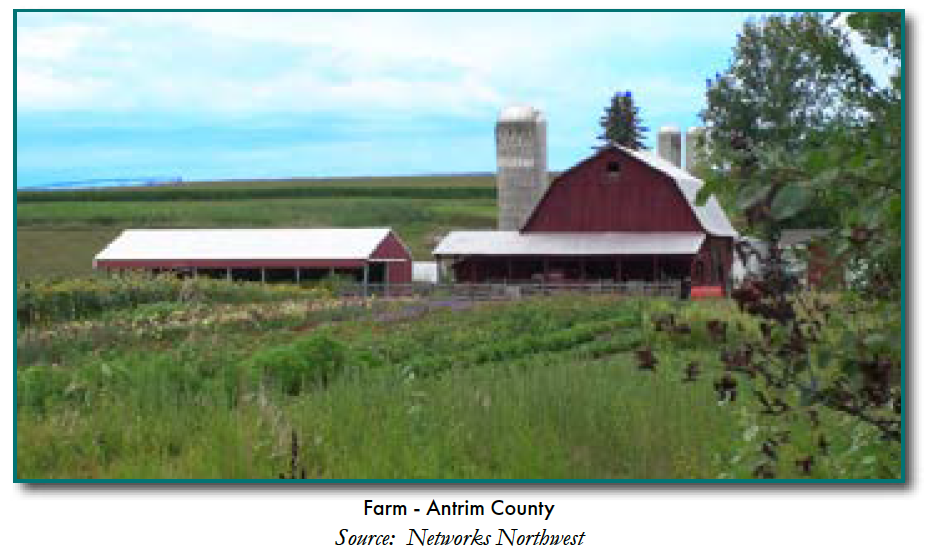
OUTDOOR ACTIVITIES
Michigan offers a wide array of wildlife-related and outdoor activities. An estimated 3.5 million people or 35 percent of the Michigan population participate in fishing, hunting or wildlife observation. A total of $3.3 billion was spent on these three activities in 2001. Tourism generated profits of more than $14.4 billion, and 157,200 jobs are directly related to tourism. Snow sports also contribute substantially to Michigan’s economy. According to the Michigan Snowmobile Association, an average snowmobiler spends $150 per day on a trip; many trips last five days or more. The sport contributes more than $1 billion to the state economy. The 16 ski facilities in the state generated nearly $50 million in 2002. All are at risk due to climate change.
BROADBAND
Today, the success of a state has become dependent on how well it is connected to the global economy and how those connections are leveraged to improve the quality of life for its residents, the sustainability and growth of its businesses, the delivery of services by its institutions, and the overall economic development of its communities. Broadband has become a foundation for economic growth, job creation, global competitiveness, and a better way of life.
The following is a snapshot of Michigan’s broadband landscape:
- Michigan ranks 30th among other states and territories for broadband availability. An estimated 368,000 rural Michigan households do not have access to broadband.
- Nearly 2 million Michigan households (48%) have access to only one fixed, terrestrial Internet service provider
- Just over $2.5 billion in potential economic benefit is left unrealized among those households not connected.
- Approximately 93.7% of households in non-rural areas have access to broadband with a speed of at least 25/3 Mbps while only 75.3% of rural households have access to similar connections. Rural broadband availability in Michigan has not kept pace with availability in non-rural areas.
- Tele-medicine application is estimated to add $522,000 to rural economies. Tele-medicine also reduces hospitalizations for nursing home patients and generates savings for Medicare.
- Communities without access to real-time data experience 25% higher rates of injuries and crime.
- In a study of manufacturers, 40% stated they were able to add new customers and 57% realized cost savings because of their broadband connections.
INFRASTRUCTURE
Infrastructure is the fundamental facilities and systems serving a country, state, county, township, or city and is necessary for its economy to function. Infrastructure includes roads, bridges, water and sewer systems, dams, transit, aviation, railways, energy and schools. Infrastructure is the foundation of our everyday lives and touches all parts of how we live, work and play in Michigan. It is the backbone of Michigan’s economy.
Our transportation system (roads, bridges, transit, rail, etc.) allows Michiganders to travel to work every day, or up north for summer weekends by the lake. Water systems deliver drinking water to our homes, communities, and businesses. School buildings provide a safe place for our children to learn. Sewer and treatment systems protect our neighborhoods from floods, and our lakes, rivers, and beaches from raw sewage, E. coli and other toxins.
Unfortunately, most of Michigan’s infrastructure is old, outdated and in need of repair. In older Michigan cities, some systems date back to the late 1800s. For close to a decade now the state has suffered from a poor economy, resulting in Michigan under investing in infrastructure. The following summaries and data were retrieved from the “2018 Report Card for Michigan’s Infrastructure”, prepared by the American Society of Civil Engineers, Michigan Section.
BRIDGES
Michigan’s over 11,000 bridges are critical connections in our surface transportation system, providing crossings over waterways, roads and railroads. A deteriorating and inadequate highway transportation system costs Michigan motorists billions of dollars every year in wasted time and fuel, injuries and fatalities caused by traffic crashes, as well as wear and tear on their vehicles. Approximately 1,234 bridges (11%) of the state’s 11,156 bridges are structurally deficient.
DAMS
Michigan’s approximately 2,600 dams support water supply, irrigation, hydro-power, and in some cases, recreation. There are 140 high hazard potential dams in the state. (Hazard potential is not an indication of the dam’s condition, but an indication for the potential for loss of life and property damage if the dam were to fail.) According to condition assessment data in the National Inventory of Dams, the state’s high hazard dams have an average rating of “fair,” scoring about 79 on a 100-point scale. According to the 21st Century Infrastructure Commission Report, $225 million is needed in additional state funding over the next 20 years to manage our aging dams in Michigan to avoid dam failures similar to the 2020 failures of the Edenville and Sanford dams in Midland Michigan.
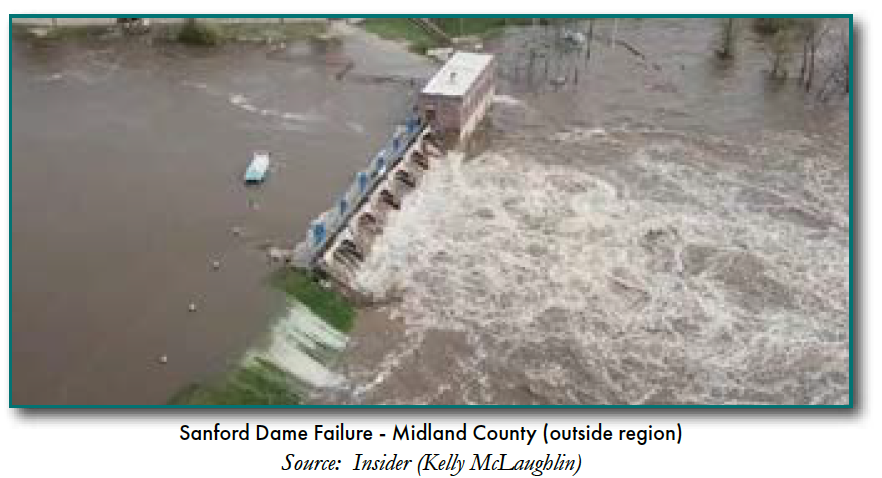
DRINKING WATER
Michigan is nearly surrounded by the Great Lakes, which contain 21% of the world’s fresh water, and is served by multiple subsurface aquifers. Yet certain drinking water system “owners” (e.g., municipalities) face scarcity concerns, contamination, and aging treatment/distribution systems that are not aligned with drinking water user needs. According to Public Sector Consultants and 21st Century Infrastructure Commission reports, failure to adequately plan for and fund drinking water infrastructure could lead to major crises affecting millions of the State’s residents.
ENERGY
Michigan’s energy systems generally meet current needs. The status is threatened by increasing energy dependence and demand for high service reliability coupled with aging infrastructure, lack of investment to preserve function, exposure to physical and cyber threats, congestion, and dependence on externally sourced fossil and nuclear fuels.
RAIL SYSTEMS
Michigan’s rail system has approximately 3,600 miles of track that are operated by 26 private railroad companies. Roughly 33 million tons move into the state and 22 million tons move out of the state by rail, with 436,240 tons moving within our region. Freight rail movements are projected to increase 49.8%, to 148 million tons, by 2030. Public dollars fund public at-grade crossing improvements and some very limited capital improvements.
ROADS
Michigan’s rail system has approximately 3,600 miles of track that are operated by 26 private railroad companies. Roughly 33 million tons move into the state and 22 million tons move out of the state by rail, with 436,240 tons moving within our region. Freight rail movements are projected to increase 49.8%, to 148 million tons, by 2030. Public dollars fund public at-grade crossing improvements and some very limited capital improvements.
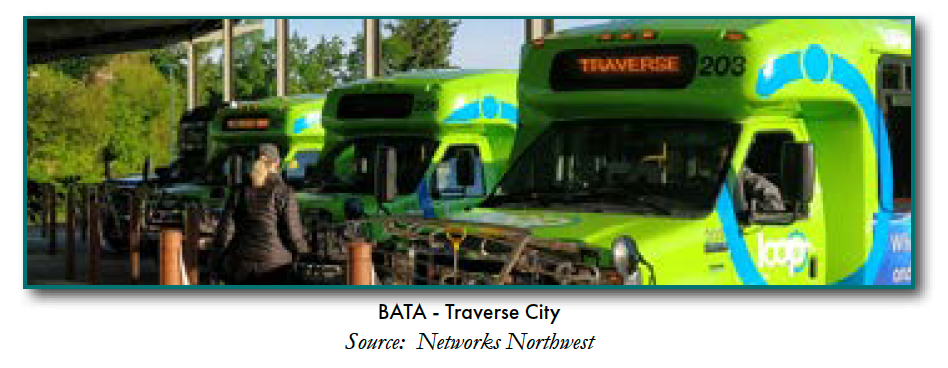
EDUCATION FACILITIES
The condition of Michigan’s education facilities varies widely both across the state, and within individual regions and districts. Access to funding for school facility improvements is largely based on the size of the local property tax base. The condition of Michigan’s K through 12 schools varies based on a region’s propensity to support property taxes for schools, and the value of the region’s taxable property. Overall, Michigan’s schools have stabilized and shown slight improvements in enrollment numbers and facility funding.
SOLID WASTE SYSTEMS
Overall, Michigan’s collection, transfer and disposal infrastructure is robust, with approximately 27 years of landfill disposal capacity remaining. Michigan is beginning to actively shift its overall solid waste philosophy toward a sustainable materials management approach to create economic opportunities through waste diversion, beneficial reuse, and recycling programs.
STORM WATER SYSTEMS
Michigan lacks a systematic approach to inventorying, operating and maintaining a storm water infrastructure, and few communities have dedicated funding sources for storm water systems.

TRANSIT SYSTEMS
While a majority of Michigan’s residents have access to some form of public transportation, the reliability and availability of these services to many areas are inadequate, and some rural systems are unable to adequately meet transit demands. All ten counties in the region have some form of transit service through public transit agencies and specialized providers. Transit may be limited in some areas in both terms of the service area and/or the individuals served. Federal funds for rural services are awarded to Michigan and programmed by the Michigan Department Of Transportation (MDOT).
WASTE WATER SYSTEMS
Michigan is surrounded by four of the five Great Lakes, and the state’s 3,288 miles of shoreline are fed by 11,000 inland lakes, 51,000 miles of river systems and 6,500,000 acres of wetlands. It is essential that these valuable assets are protected, and our $15 billion water economy is sustained by proper operation, maintenance, and rehabilitation of our wastewater infrastructure. Michigan has been making great strides in asset management with assistance from the Department of Environmental Quality’s Storm water, Asset Management, and Wastewater grant funding.
AVIATION
The region has two airports classified as “small non-hub airports” and numerous “local basic” and “unclassified” airports throughout the region. The bulk of capital funding improvements to the aviation system are provided with federal Airport Improvement Program (AIP) funding through the Federal Aviation Administration (FAA). The conditions and overall safety of the aeronautical infrastructure has been well monitored and maintained through an asset management concept described in the Michigan Aviation System Plan.
